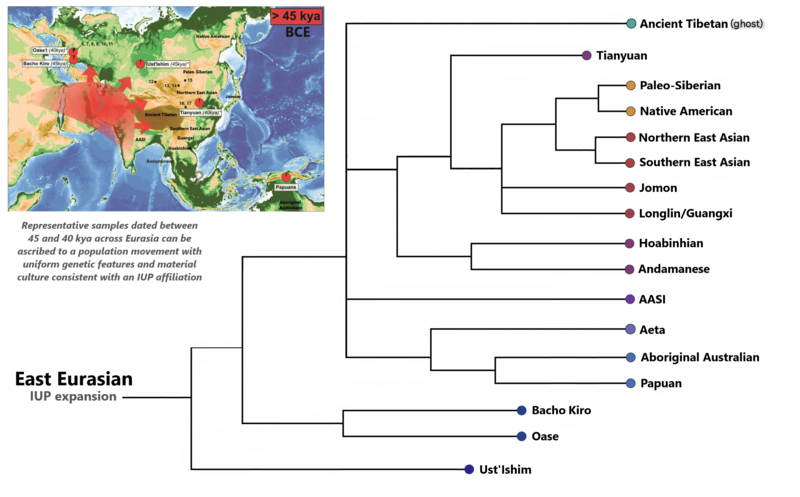Image: Phylogenetic structure of Eastern Eurasians

Description: Phylogenetic structure of Eastern Eurasians; displaying the genetic affinity and distance between different Eastern Eurasian lineages and their inferred diverging patterns. Population hub graphic (upper left) shows the distribution of Paleolithic specimens associated with the IUP expansion >45 kya. Taken from (https://commons.wikimedia.org/wiki/File:Repetitive_expansions_into_Eurasia_from_a_population_Hub_OoA.jpg) Note: Northern East Asian and Southern East Asian specifically refers to the population genetic lineages of "Ancient Northern East Asians" (ANEA) [not to be confused with "Ancient Northeast Asians" (ANA)] and "Ancient Southern East Asians" (ASEA). The phylogenetic tree is primarily based on the summary by Yang 2022: Australasian (AA):"primarily contributed to human populations in Australasia, or the region consisting of Australia, New Zealand, and neighboring islands in the South Pacific Ocean. Represented primarily by present-day Australasians, e.g. Papuans and Aboriginal Australians.", indigenous South Asians (AASI):"primarily contributed to humans living in South Asia, particularly southern India. Partially represented in 5,000–1,500-year-old individuals from in or near the Indus Periphery and present-day Indians [59,60].", and East/Southeast Asians (ESEA): "Together, the genetic patterns described above show that the ESEA lineage differentiated into at least three distinct ancestries: Tianyuan ancestry which can be found 40,000-33,000 years ago in northern East Asia, ancestry found today across present-day populations of East Asia, Southeast Asia, and Siberia, but whose origins are unknown, and Hòabìnhian ancestry found 8,000-4,000 years ago in Southeast Asia, but whose origins in the Upper Paleolithic are unknown." Hoabinhian ancestry was found to be the most basal ESEA branch:"All other labeled ancestries are subsets of ESEA lineage, where Hòabìnhian ancestry (yellow region) is deeply diverged from all other labeled ancestries". "Rapid diversification of an ancestral Asian population led to at least three Asian lineages, associated with Australasians and [Philippines] Negritos (AA), South Asians and Andamanese Islanders (AASI), and East and Southeast Asians (ESEA). Sampling across time and space in eastern Asia indicated that the ESEA lineage was highly sub-structured in the Upper Paleolithic, and populations across Siberia, East Asia, and Southeast Asia are associated with many distinct ancestries. Today, most populations from Siberia, East Asia, and Southeast Asia are associated with a mix of ancestries sampled predominantly in ancient individuals of East Asia." Another distinct deep ancestry ("Ancient Tibetan") is representing the Paleolithic ancestry of the Himalayan plateau. The most basal/deep Eastern Eurasian associated ancestries are represented by the Initial Upper-Paleolithic Ust'Ishim, as well as Bacho Kiro and Oase specimens.
Title: Phylogenetic structure of Eastern Eurasians
Credit: Own work; data taken and based on:[1][2][3][4][5]
Author: Wikiuser1314
Usage Terms: Creative Commons Attribution-Share Alike 4.0
License: CC BY-SA 4.0
License Link: https://creativecommons.org/licenses/by-sa/4.0
Attribution Required?: Yes
Image usage
The following 2 pages link to this image:

